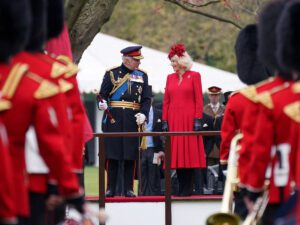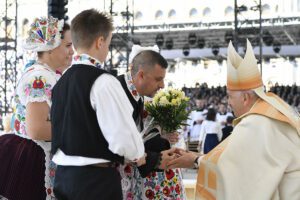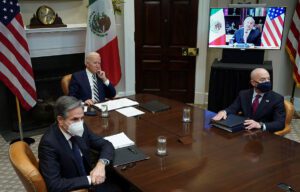(OSV News) – When King Charles III is crowned May 6 in the gothic splendor of London’s ancient Westminster Abbey, it will be one of the year’s most watched events.
The coronation has attracted controversy – not least over its $125 million price tag during a cost-of-living crisis – even as opinion polls show dwindling public interest in the monarchy. But despite controversies, it will still be an opportunity to project the soft-power of British royal pageantry and reaffirm Christianity’s place in public affairs, including the presence of Britain’s small but significant Catholic minority.

“Being anti-Catholic has been an element of British identity for centuries,” Father Timothy Radcliffe, former master of the Dominicans and one of Britain’s best-known Catholic preachers, told OSV News. “I’d hope an event like this will help our church become yet more integrated into national life at a time when, like most countries, we face threats of disintegration, increasing inequality and a declining sense of the common good.”
King Charles inherits the duties and prerogatives of head of state in an unbroken line of monarchs dating back to the 10th century. He also assumes the role of supreme governor of the Church of England, along with the traditional title of “fidei defensor,” or “defender of the faith,” bestowed in 1521 by Pope Leo X on King Henry VIII.
And while he’s long declared his wish, in a modern multicultural society, to be defender of all faiths, not just one, King Charles III reaffirmed his Protestant identity in speeches after the death of Queen Elizabeth II in September 2022 — and will reaffirm it again during the coronation service.
This has caused some disappointment, not least among Britain’s Catholics.
The Catholic Church will be represented at the abbey by Cardinal Vincent Nichols of Westminster, who will share a blessing with Protestant and Orthodox leaders. Catholic bishops from Wales, Scotland and Northern Ireland also will join the congregation, along with the Vatican’s secretary of state, Cardinal Pietro Parolin, and the newly appointed apostolic nuncio to Great Britain, Spanish Archbishop Miguel Maury Buendía.
But Catholic prelates were not included among 50 public figures assigned formal roles in the order of service, published April 28. This will include a Bible reading by Britain Prime Minister Rishi Sunak, a practicing Hindu, and the presentation of regalia by Muslim, Jewish, Sikh and Hindu leaders.
Susan Doran, an Oxford University monarchy historian, said she regretted the bulk of the ceremony will be exclusively Protestant, with Archbishop Justin Welby of Canterbury and other Anglican prelates playing a dominant role.
“With its plummeting membership and many problems, it’s not surprising the Church of England seeks to hold on to its link with the monarchy, and sees the coronation as an opportunity to proclaim this,” Doran told OSV News.
“But at a time when the monarchy seems to be losing meaning for many people, I think it will fuel further alienation if they go too far down a narrow Protestant route — particularly among the young and people of other faiths,” she added.
That could be the reaction of some Catholics, too, especially those conscious of how bitter past conflicts have defined modern Britain’s religious outlook.
Relations with Rome, dating from the first mission to Anglo-Saxon kingdoms in the sixth century, were broken off under Henry VIII in 1536 during the Reformation conflicts. After a brief restoration under Henry’s Catholic daughter, Mary I, hostility reared again under the Protestant Elizabeth I, who was declared excommunicated and deposed as a “servant of wickedness” in 1570 by Pope Pius V.
Persecution of Catholics intensified under Elizabeth’s successor, James I, particularly after the infamous 1605 Gunpowder Plot to blow up the king and his parliament. Some historians now dispute whether such a plot really existed. But it sealed the fate of English Catholics for the next 250 years as perceived heretics and traitors.
Even in the late 19th century, the Catholic Church was treated as an alien element in national life, deprived of equal rights. Although a church hierarchy was reestablished in 1850, it took until 1871 for Catholic academics even to be admitted to Oxford and Cambridge universities, and until St. John Paul II’s historic 1982 visit for formal diplomatic ties to be established.
Since then, the Catholic Church’s profile has been rebuilt, bringing it closer to full acceptance as a British institution.
Recent statistics show that Catholics make up around 13% of the United Kingdom’s 67 million inhabitants, with Anglicans at 14%, although religious affiliations have declined sharply across the country, with only around half of citizens declaring themselves Christian in recent surveys, compared to more than 70% two decades ago.
Although King Charles’s consort, Queen Camilla, was baptized a Protestant, she was married by a Catholic priest in 1973 to her Catholic first husband, Andrew Parker-Bowles, and brought up her son and daughter as Catholics.
Technical formalities aside, Charles has shown personal openness to Catholics, postponing his own wedding to Camilla in 2005 to attend St. John Paul’s funeral.
Before his fourth Vatican visit in October 2019 for the canonization of St. John Henry Newman, Charles published an article in L’Osservatore Romano and The Times of London hailing the event as a celebration “not merely for Catholics, but for all who cherish the values by which he was inspired.”
Heading a 12-member Catholic delegation to pledge allegiance to the new king March 9, Cardinal Nichols duly paid tribute to Charles’s “commitment to religious faith” and assured him of Catholic support.
On April 19, the pope himself reciprocated, donating two splinters from the Cross of Christ, preserved among relics in the Vatican Museums, for incorporation into a new Cross of Wales, which will lead the king’s coronation procession.
The king will be crowned as he sits on a 700-year-old chair with the solid-gold St. Edward’s Crown, made for Charles II in 1661. He will be presented with the orb and scepter pictured last autumn sitting atop the late queen’s coffin.
Holy oil for anointing the monarch and Camilla was consecrated March 4 at Jerusalem’s Church of the Holy Sepulcher by the Greek Orthodox Patriarch Theophilos III of Jerusalem.
Cardinal Nichols and other British Catholic bishops urged Catholics to take a full part in coronation events, including special weekend Masses and a May 3-5 triduum of prayer, as well as a nationwide day of volunteering and charity work set for May 8.
“The world has immeasurably changed since 1953 (coronation of Queen Elizabeth II), with many more opportunities and challenges,” Cardinal Nichols acknowledged in a prayer card circulated to all parishes in April. The prayer asks God to help Charles III “constantly secure and preserve for the people entrusted to his care the freedom that comes from civil peace.”
Father Radcliffe, the Dominican preacher, hinted at his own disappointment, all the same, that the Catholic Church won’t be assigned a fuller part, given the “godly role” it’s always tried to play in society.
“Catholic social teaching could be a precious gift for a nation needing to renew its social bonds and rediscover a common life and purpose,” Father Radcliffe told OSV News.
Cardinal Nichols’ spokesman, Alexander DesForges, was more sanguine. Although Catholic clergy aren’t playing a significant role in the coronation, they’ll at least be present – for the first time since Henry VIII and his Reformation.
“We have to be realistic. The king has a formal role in the Anglican Church of England, and this service is taking place in Westminster Abbey,” DesForges told OSV News. “The fact that six bishops will be present, including the Vatican’s Cardinal Parolin, whereas there was no Catholic representation at all 70 years ago, clearly shows things have changed.”


